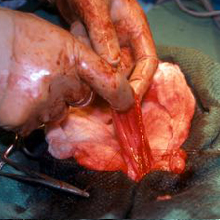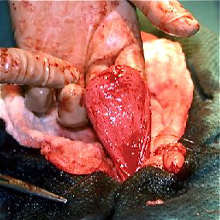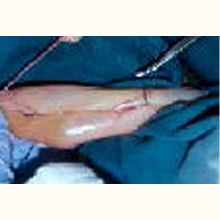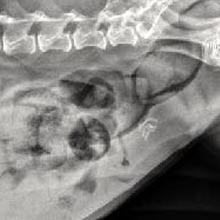Exploratory Laparotomy
What is an Exploratory Laparotomy?
The exploratory laparotomy, often referred to as the Ex Lap, is a diagnostic tool. The surgery is performed when the diagnostic tests readily available to a practitioner do not provide an explanation for the patient’s abdominal clinical signs. The ex lap can help you get answers and solve a problem.
Situational Awareness
The Ex Lap can be both lifesaving and money sparing when used appropriately and timely. The difficulty associated with this surgery is the level of associated uncertainty. Some questions you may be asking yourself are:
- Will I find the foreign body (FB)? What if I don’t?
- What if I find a tumour? What if I don’t?
- Will the problem be beyond my skill level?
The key is for you and your client to be prepared, clearly there is no possible way to be prepared to surgically manage every possible scenario, but you can prepare for how you will handle different types of situations. You will either come out of the ex lap with the FB, with the diagnostic biopsies, maybe with pictures, samples and recommendation for referral or maybe a recommendation for euthanasia, but you will have an answer and a plan. You, your patient and your client will no longer be stuck in the ‘not knowing’.

Get ready to perform an Ex Lap
All the information you need.
Fully narrated surgical videos.
In depth guide and more.
Fully narrated surgical videos.
In depth guide and more.
This content is designed for veterinary professionals. If you are a pet owner, please consult your vet if you have any questions about a surgery.
Pre-Surgical Considerations:
Indications for performing an Ex Lap:
- Suspected FB that can not be confirmed with available diagnostic tools.
- Scope of injuries need to be determined (and treated) after abdominal trauma has been sustained.
- Unresolvable GI/abdominal issues (chronic diarrhea/vomiting) with symptomatic treatment.
- Advanced diagnostic tests not available in a timely fashion.
Pre-operative preparations:
- Bloodwork (including electrolytes) and urinalysis to determine metabolic status of the patient.
- Ensure the patient is hydrated and stable for general anesthesia
What the client needs to know:
- This is a diagnostic tool
- There is a good chance we will find something that we can solve
- Biopsies will help us get to a diagnosis even if the problem is not grossly evident
- The scope of the problem is beyond repair/ability – we will get biopsy and call to re-assess
- The alternative is to get an ultrasound (timing, availability, costs)
Step by Step Ex lap

- Step 1
Liver Biopsy: Create a loop with the suture material (3-0 monofilament will work well). Ensnare the tip of a liver lobe with the suture loop.

- Step 2
Liver Biopsy: Pull the suture loop tight around the liver lobe tip, thereby strangulating the parenchyma and vessels. Cut the liver tissue leaving the suture material in situ. Place the liver sample in formalin.

- Step 3
Intestinal biopsy: With a #15 blade make a small incision (about 1cm long) along the mesenteric border of the loop of bowel.

- Step 4
Intestinal biopsy: Using Metzenbaum scissors excise a FULL thickness strip of tissue, about 1mm wide, along one edge of the incision. Place the sample in the formalin jar.

- Step 5
Intestinal biopsy: Close the biopsy site with a simple interrupted, full thickness, apposing (not crushing) pattern. I like to start the closure in the centre of the enterotomy and I use a 3-0 or 4-0 shorter acting monofilament suture material.

- Step 6
Intestinal biopsy: When the closure is complete, do a leak test before moving on.
Get ready to perform an Ex Lap
Preferred instrumentation:
- Laparotomy sponges
- General instrument pack
- Doyens
- Abdominal retractor (especially in larger dogs)
- Biopsy jar
Post-operative Considerations
- The post-operative management will vary depending on what was found and done at surgery.
- If the ex lap was routine with only biopsies needed then consider NPO for 8-12 hours
- Manage the pain from the abdominal surgery
- Antibiotics may not be necessary or only used for 24-72 if aseptic technique was followed in light of the GI biopsies and no signs of infection were noted at surgery.
- The abdominal incision should be allowed to heal properly with minimal activity for a 2 week period.
What you get when you register
The course is approximately 1 and 1/2 hours of information on the Ex lap.
It is difficult to depict a full exploratory laparotomy using pictures but the course registration includes a fully narrated video of an Ex Lap with all its biopsies. You can see my technique and I describe some important key points such as how to assess the gall bladder and view the dorsal gutters (where the kidneys and adrenal glands are located).
Price: $325 CAD
Q & A
How long does an exploratory laparotomy take?
The exploratory of the abdominal organs, once the approach is complete, only takes between 5 and 10 minutes, depending on how many anomalies there might be to observe and consider. However, taking the biopsies of the various organs can be time consuming. The abdominal incision is also of a significant length so closure can also take some time. An ex lap can easily take 60-70 minutes skin-to-skin (assuming no major anomalies found and all usual organs biopsied).
How long does it take a dog to recover from an ex lap?
The recovery from this surgery is very much dependent on what has been found at surgery and how ill the patient was going into surgery. However, the recovery tends to be speedy with a routine ex lap and biopsies in a stable patient. The abdominal incision will take approximately 2 weeks to heal.
Subscribe to our newsletter and receive 15% off a workshop of your choice!
Workshops & Courses
Blog
 The Secret to having the Bandage stay Above the StifleJuly 3, 2024 - 1:44 pm
The Secret to having the Bandage stay Above the StifleJuly 3, 2024 - 1:44 pm Common Mistakes made by Veterinarians when doing the Drawer TestJune 26, 2024 - 9:22 am
Common Mistakes made by Veterinarians when doing the Drawer TestJune 26, 2024 - 9:22 am Burying the end knot in a continuous subcutaneous suture patternJune 19, 2024 - 7:35 pm
Burying the end knot in a continuous subcutaneous suture patternJune 19, 2024 - 7:35 pm Creating Donuts for your BandagesJune 12, 2024 - 3:15 pm
Creating Donuts for your BandagesJune 12, 2024 - 3:15 pm The Knotless Suture PatternJune 5, 2024 - 2:45 pm
The Knotless Suture PatternJune 5, 2024 - 2:45 pm

